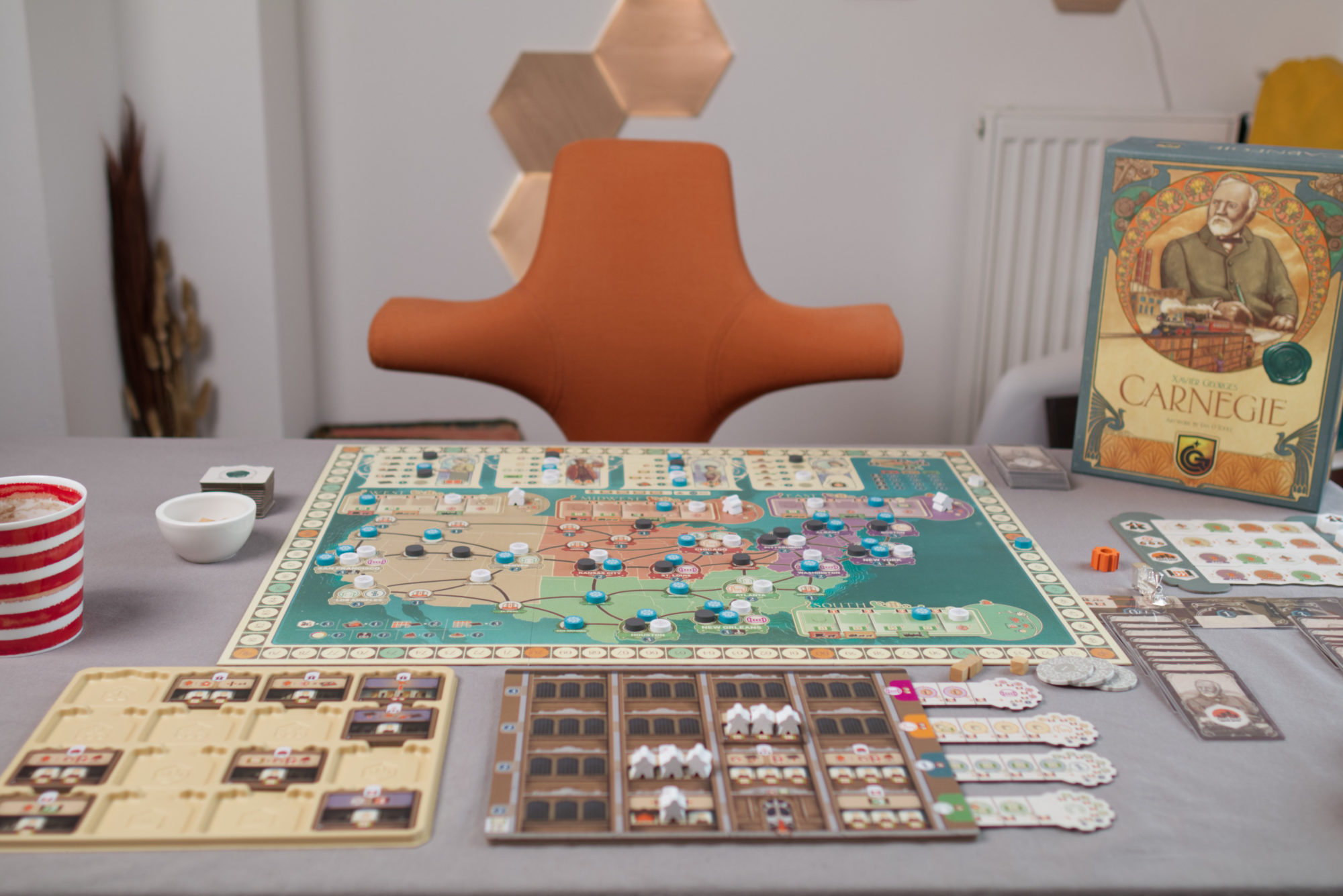One of my favourite experiences in board gaming is being unexpectedly blown away by a game. I realise I’m tipping my hand here as to what direction the conclusion of these first impressions will likely go, but let’s stick with it. I fondly remember the day when I picked up a second hand copy of Dune: Imperium completely sure I wouldn’t like it. I had watched a review and hadn’t made it to the end because I got bored. I saw the game board and didn’t like the graphic design. Still, I had greatly enjoyed reading the book as a teen, loved the movie (well, I was young and impressible), so I wanted to know what the game would be like to play. I started the evening expecting nothing except disappointment and ended up pre-ordering the deluxe upgrade box before I had finished the game. Personal game of the year, hadn’t even seen it coming. That was a great evening!
To not get completely ahead of myself, let’s just say my initial experience with Carnegie was surprisingly similar: I had heard a lot of praises but every time I started watching a video review, I doze off and got on with better things. Can you blame me? The thematic setting is as bog-standard as they come, there is a board with cities and connections, a company area that reminded me of Power Struggle (which I actually enjoy quite a lot; it reminds me of some former employers of mine), wads of money. If you knew nothing about Carnegie, you might think Ian O’Toole stepped into his time machine and went back to the 90s to give Medieval Merchant a much deserved upgrade. Funny enough, I just realised he actually did the art for Franchise! But I digress…
If you’re still on the fence regarding Carnegie or have already decided not to bother, this is for you. Grab a cup of tea, dig in, and enjoy as I try to give you the part of the story that Carnegie’s looks and those reviews were not able to impress on me.
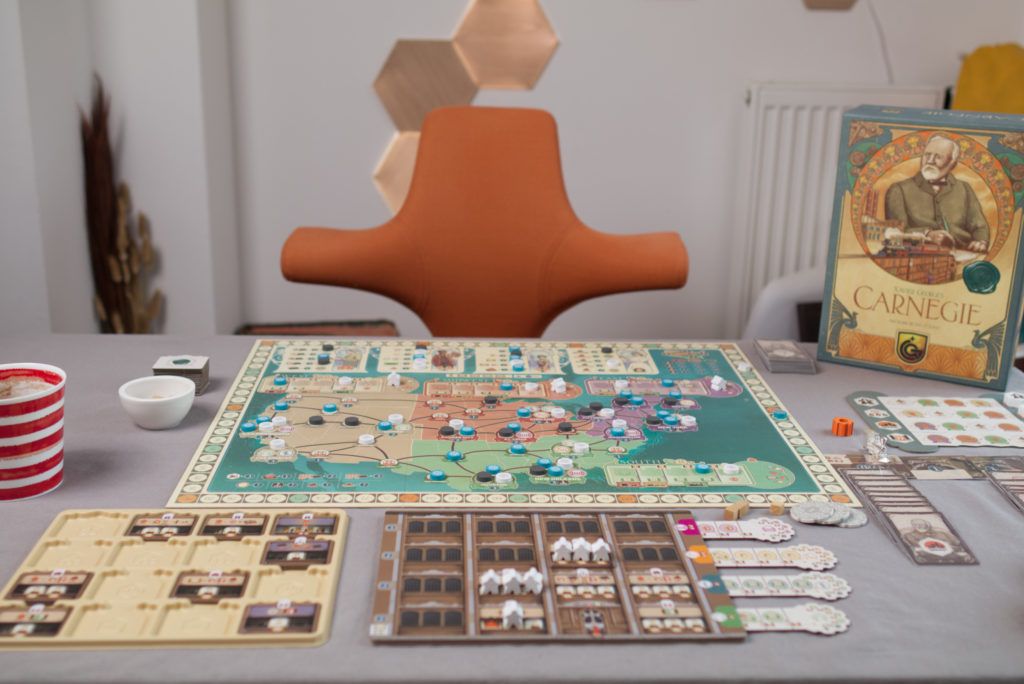
Setup
Setup takes a couple of minutes as there are more steps than one might initially assume. But once you know it, it’s done rather quickly. There are four main parts: First and foremost, there is the timeline constructed of four strips framed by two side pieces. It might look like the least impressive part of the game, but I’m mentioning it first for a reason: it’s the beating heart of Carnegie, the one thing that has the largest implications and will cause the biggest amount of agony or feeling of superiority. Which of the two it will be not only depends on whose turn it is but also in what situation you have manoeuvred yourself in previous rounds. Each strip is associated with one of the four possible actions (as indicated on the thick markers) and shows a combination of regions and donation fields. There is a set of 8 strips, printed front and back, which allows for a different combination pretty much every game.
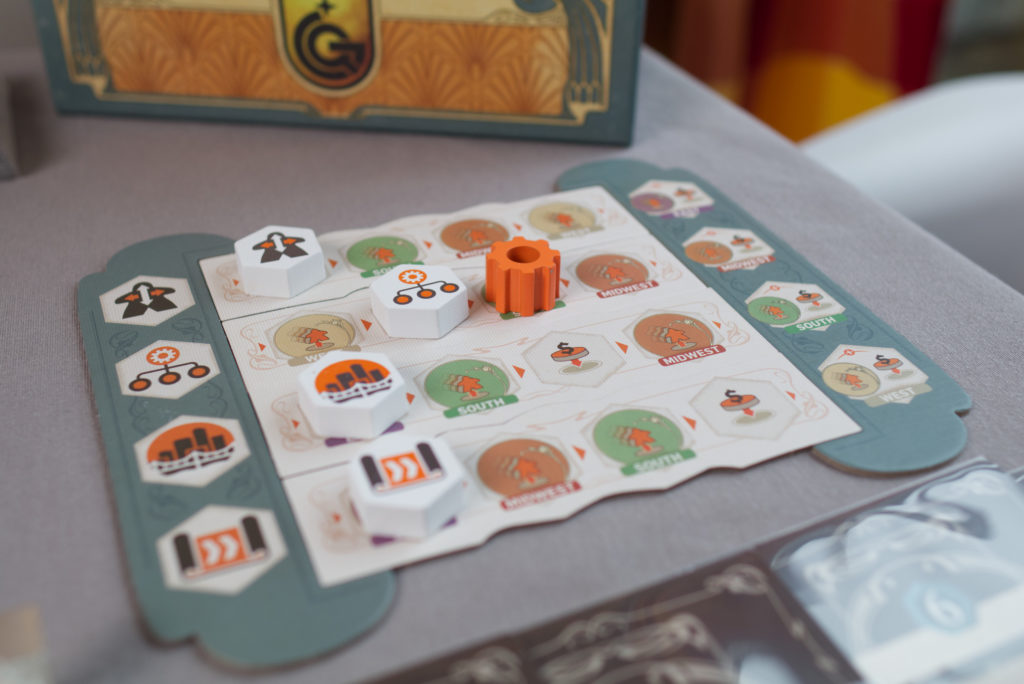
Each round, one of the players will select an action for all players by placing the orange gear token to the right of the white action marker, deciding both the action and the region/donation that is triggered. More on that later.
Next in order of importance comes your personal company board. It shows a lobby where meeples will come in and a number of departments where they can be put to work. Each department has a function printed on it and a limited number of work spaces for your meeples to work in. The more active (standing up) meeples you have in there, the more often you can use that function. Some departments are already printed on the board, others can be purchased during the game. During initial setup, one of your workers is placed standing up into each department, representing that they actively work there. The rest of your initial meeples is placed lying down in the lobby. To put them to work, you’ll have to move them to departments and then spend money to activate them.
On the side, there are also four different project tabs that are completely slid into the board with wooden discs placed on their ends. The discs represent the projects you can later fund (=place on the map) throughout America: public infrastructure, industry, commerce, and housing. The fields for projects are never refilled. If you want to do further projects, you have to spend development on those tabs in order to slowly pull them out, revealing new places that discs are put on only at the time they are first revealed. Want to build three public infrastructure projects? You’ll have to develop it three steps out.
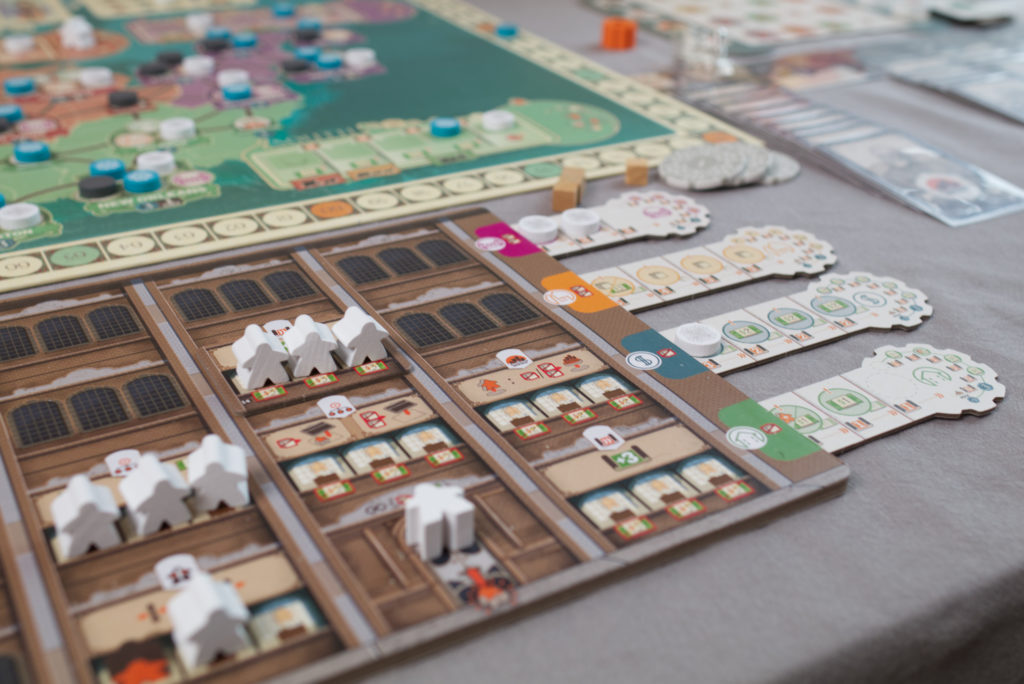
The biggest component is the central main board. It shows a number of large, medium and small cities where the difference is in the number and type of spaces for projects. The map is split into four regions: the west, mid-west, south, and east. Each region also has its own transportation track where you can upgrade your position to increase income when that region is triggered. Finally, there are four areas of possible donations that you can do during the game and that will cost you increasingly exorbitant amounts of money but give you VP at game’s end.
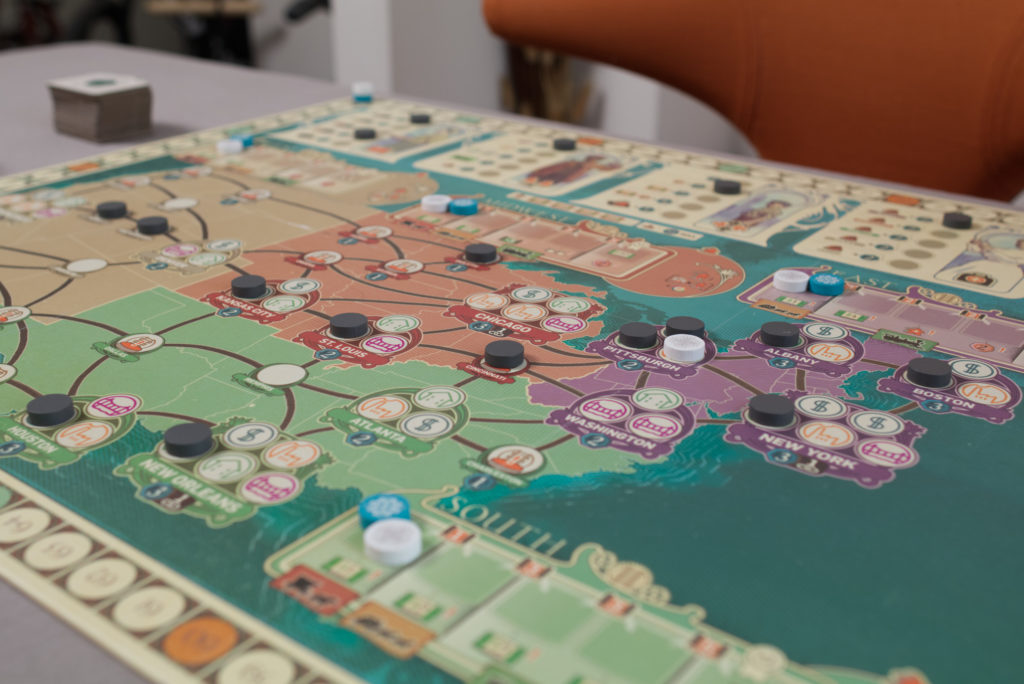
During initial setup, the solo automa deck is used to place discs onto the map that will make projects and donations inaccessible for the whole game. The number of disks depends on player count and ensures that both the map and choice of donations will feel tight regardless of player count. It also forces all players to work with what’s available instead of sticking with the same strategy all the time.
Finally, there is the market where players can purchase additional departments, giving them unique ways of using their workers. There are two of each but again, depending on the player count, a number of departments are removed from the game before it even starts. So your favourite department might not even be available in the next game or only a single tile that will be hotly contested.
The Turn
As the very first thing during each round, the active player chooses which type of action all players will do that round: Human Resources will move meeples around in your company, Management will generally let you produce money/goods or build new departments, Construction allows you to place new projects on the map, and R&D will make new projects to build available to you or improve your income situation. The active player uses the orange gear token and places it to the right of the marker of the action she wants to trigger. This will then trigger the event the gear token is placed on: either each player will be able to make a donation (if they can pay the increasingly exorbitant amounts of money those required) or score income in the region that is indicated on the timeline.
Income is a tricky thing in Carnegie: there is no fixed one! In order to get any at all, you have to have workers of your own in the region that is triggered. Workers are send to a region as a side effect of one of your department functions, e.g if you want to build a project in the east, you’ll have to remove one of your meeples from the construction department and place it into a holding space in that region. When the region is triggered, you can choose to remove meeples which has three effects: 1) you place the meeple back in the lobby of your company and it becomes available again. 2) for each meeple removed you get income depending on your position on that region’s transportation track (this can be improved with R&D). And most importantly 3) only if you remove any meeple at all will your already built projects produce income. All those nice factories you might have on the board, they don’t do anything unless you are able to remove a meeple from the active region. Missed to put one there in a previous round? Bad luck, no income for you. Or to see it in a more positive light: no one except for you has workers in a region? Great time for you to triggered that region.
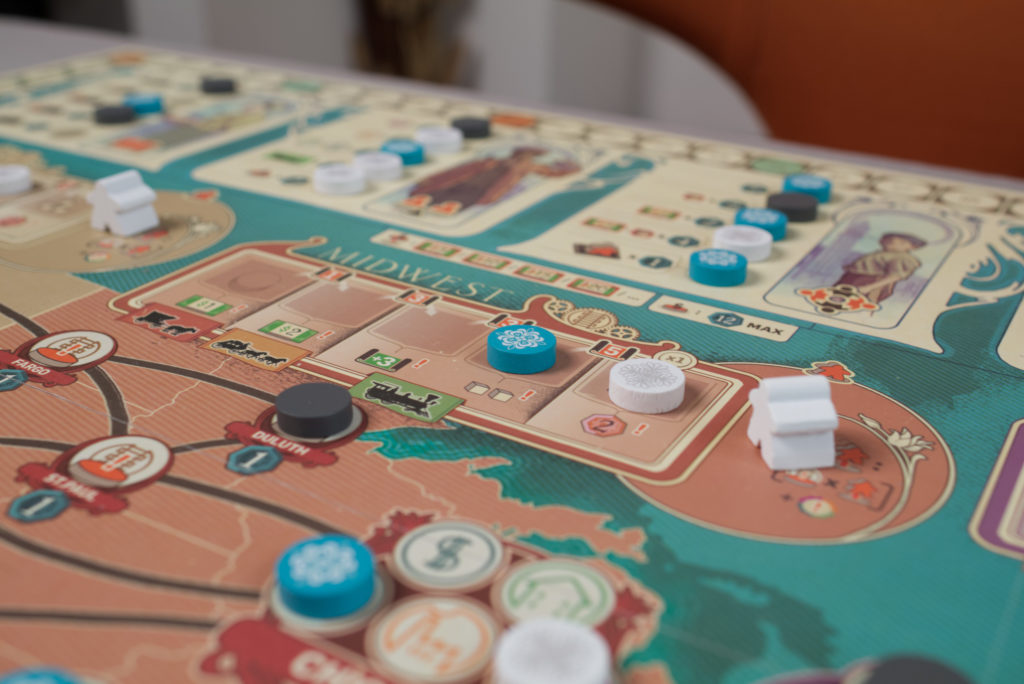
Once donations or income are done, it’s time for the players to put their workers to … well … work. Where the timeline tells players what type of action they will all be able to do that round, it’s the departments and workers in them that will decide what that actually means. Think of it like this: the timeline powers up one of the four categories of departments, but what you can do with it depends on which departments in that category you have and if there even is any worker in there at the time they are triggered. As an example, let’s say Construction is triggered. The engineering department is part of Construction so you check how many standing-up meeples you have there. For each one, you can remove it from the department and put it into the holding area in a region to construct one project in that region. Have three meeples there? You can build up to three projects, assuming you have the required project discs available on your projects tabs and the required goods cubes to pay for them. If there is no meeple in that department or they are all lying down, well, no new projects for you.
Finally, as last step in the round, the timeline action marker is advanced to the field where the orange gear token had been placed and each player can pay money to activate meeples that are lying down in departments. This creates a very nice cycle over multiple rounds: use workers to do the department function which often places them into one of the regions, which allows you to remove them when it is time to produce income so they end up in your lobby to be moved to departments in later rounds.
End of Game
The game ends after the 20th round, the same time all four action markers will have reached the right side of the timeline. Note though that that doesn’t necessarily mean each action can only happen 5 times in the game. You can place the orange gear token in a row where the action marker has already reached its end and in that case, simply the next spot of the row beneath it is triggered. So if you trigger Construction, the spot in front of the R&D marker is triggered. As a result, before the game even starts, players can see how often each region will be triggered during the game (as indicated on the timeline strips) but how often Construction happens depends on what actions the individual players choose.
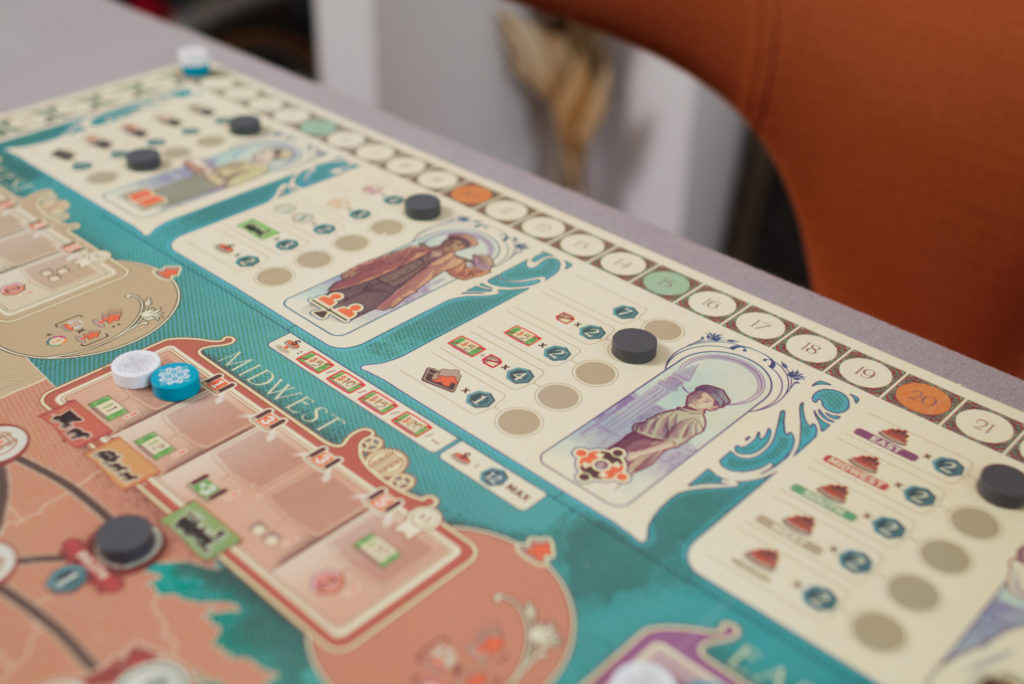
The largest amount of VP comes from the projects you build during the game and the donations you have done. Each donation gives you a multiplier for something, for example the number of construction departments you have build or the number of projects you have build in a specific region. You also get points for new departments constructed, still active workers in your departments, a bonus for connecting certain cities on the map, and a few other minor things.
Solo
The included solo mode comes in the form of an automa deck and recreates the experience of a 2 player game. The automa uses project discs, constructs projects and does donations but doesn’t care about money, resources, or departments. There are multiple aspects to this automa that are – at least to me – quite novel. For one, the back side of the cards is actually relevant. Each turn, one first takes the top card of the automa deck and places it still face down to the side. That is the active card. The back of the card indicates both the action the automa chooses if it is his turn as well as the action the automa can make the most use off if it is the human player’s turn. In the former case, simple flip over the card, set the orange gear token accordingly and perform the action printed on the card. If it’s your turn, you decide which action to use this round and only then reveal the card. Note though that you can (and should) take into account the just revealed new top card of the automa deck as that will tell you what the automa is planning to do next round.
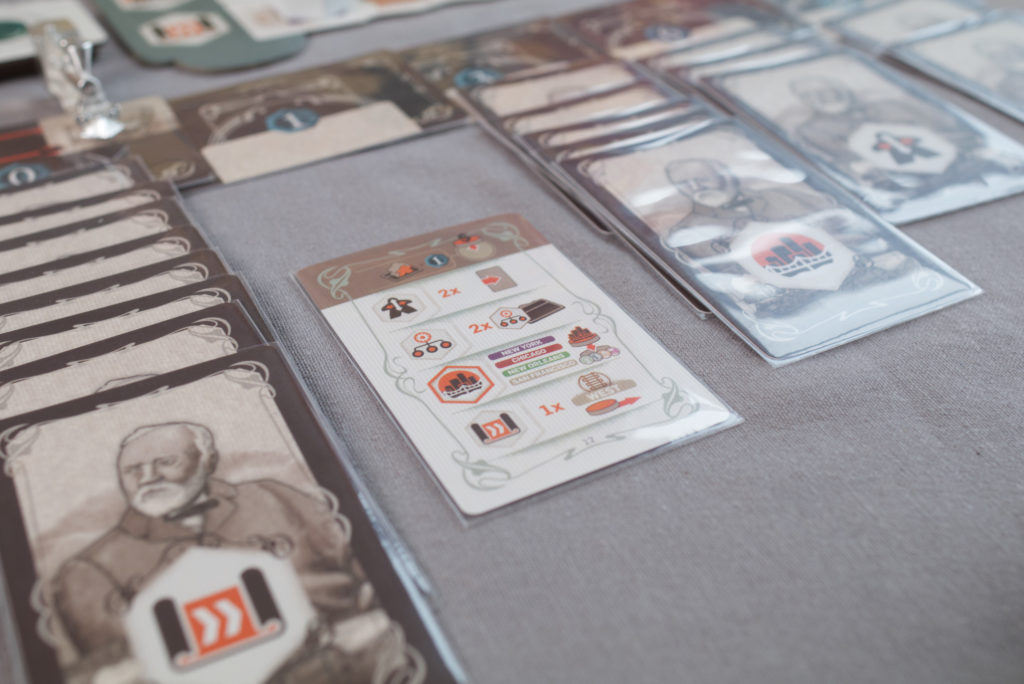
Instead of a company board, the automa has its own playing area consisting of multiple rows with increasing VP points. Whenever the automa isn’t able to complete parts of its card, the active card will be moved one step further to the right and at the end of the turn be flipped over to score that many points. Otherwise, just do what’s printed on the card: HR moves the active card further to the right (so just produces straight VP), Management has it remove departments from the market, Construction places disks on the board and R&D advances its position on the transportation tracks. The card also indicates at the top which donation the automa wants to claim when the time comes. To increase the difficulty, more and more cards of the deck can be replaced with those that don’t reveal the action the automa wants but instead have a question mark on their back. But even the normal level with just 5 out of 20 cards is already a good challenge!
The automa is well done and captures the essence of a multiplayer game: timing and figuring out which actions benefit yourself the most without giving the same or an even bigger benefit to your opponent. It blocks you from connecting cities, picks donations you were hoping to grab and so on. One neat trick is that the automa does not score donations based on what it build but what you build! So if it gets 2VP for each city in the east, it is 2VP for each of YOUR cities. This can seriously throw a wrench in your plans of for example constructing a lot of factories when it grabs the respective donation and then scores 3VP for each one you build.
I really like the automa and would even go as far as recommending Carnegie if you consider it as a solo-only game. The only tricky bit is to keep track whether it is your or the automa’s turn to pick this round’s action. While there is even an area on one of the automa cards to track exactly that, I’ve found myself multiple times so deep in thoughts that I had accidentally forgotten to update it and had to backtrack a turn.
Kickstarter & Expansion Content
I haven’t had the chance to check out a copy of the retail edition myself, but as far as I understand it the biggest differences are the lack of trays, token upgrades, higher quality components, and expansion content. The later is probably the biggest reason to get the KS edition. There are additional departments to bring in more variation and a way to have asymmetric starting situations (e.g. one player choosing to start with less money but more workers). So far, I haven’t even used any of it because the initial blockage and department removal already introduces a healthy amount of variability. I’m happy to have them because I can see myself playing Carnegie a lot but if you only get the retail edition, I would say you are good for a long time even without the expansion content.
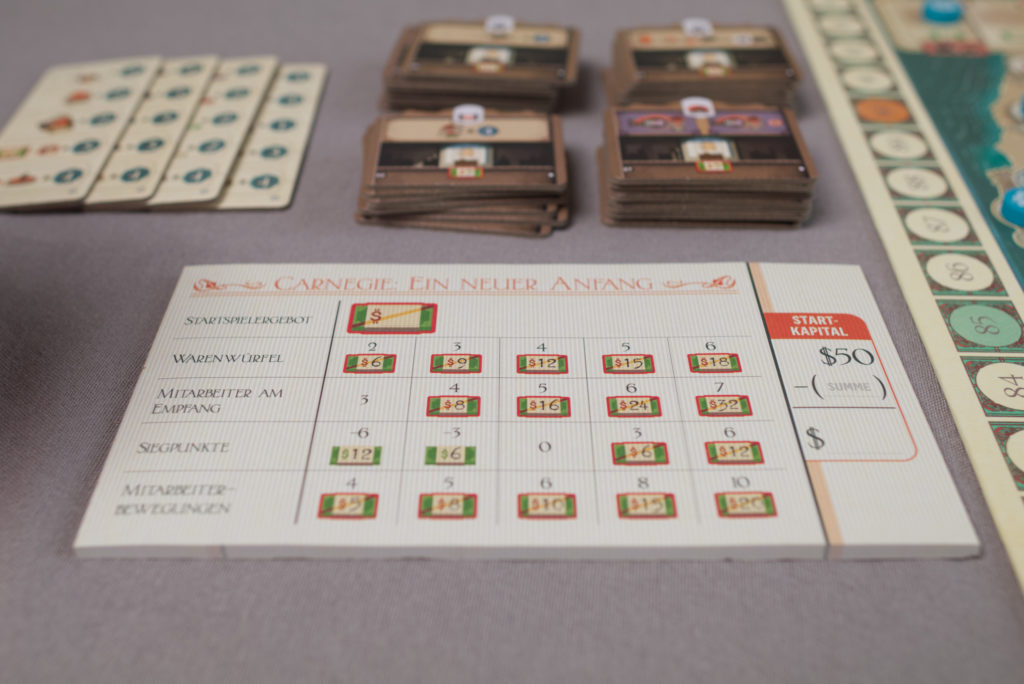
One thing worth mentioning is that this is the very first time I’m really happy with what GameTrayz has done. From the player trays to the larger in-box part, they work great and feel great. The attention to detail goes as far as that there was a pack of sleeves in the bottom tray in an area that doubles as a second slot for cards. So if you sleeve them, there are two bays to put them in. There are so many games that don’t allow for enough space to put sleeved cards in the trays that this was a nice thing to see. However, there is no top lid so the cards slide around a bit when storing the box vertically.
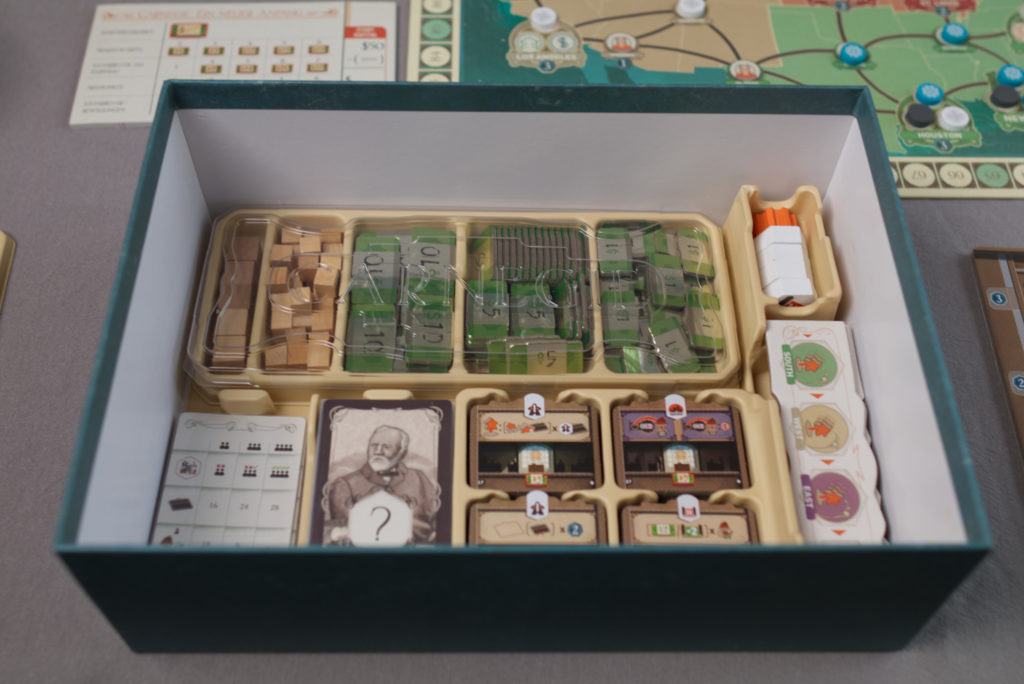
The player trays in particular are quite nifty with dedicate areas for starting money and goods, the four project tabs and everything else you need.
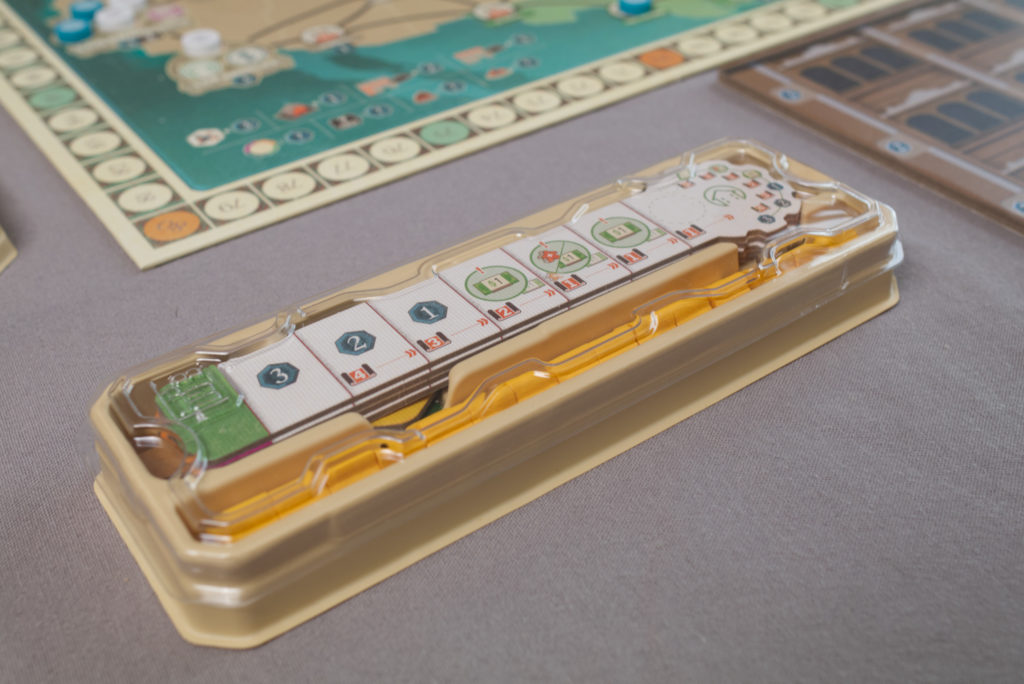
So while it was a bit of a risk to get a KS edition despite not having it made through a single review video, I’m really glad I did. I even like the spot UV on the box! The one thing I don’t like is the shiny wads of money. I’ve started using Iron Clays instead and am currently trying to acquire the metal cube upgrade. The wooden cubes are perfectly fine, but it feels like this game deserves a bit of bling!
Conclusion
Well, I’m a bit shocked at how much I like Carnegie. While the artwork is lovely (thanks Ian!), the setting and components had initially turned me off. Just another game of workers, companies and a map on which to connect cities? Nothing could be further from it. I haven’t experienced such a tight game cycle since Kanban EV and Carnegie feels even tighter. It’s like skipping rope but with barbed wire. If you don’t get your workers into the right regions at the right time, you completely miss income. If you send them too early, they will stay there for a long time and you will run out of workers for your departments, completely crushing the efficiency of your actions. Once you get them back, you have to move them to the right departments and have the cash to re-active them before one of your opponents triggers an action that might catch you with no active workers at all. There is so much anticipation and timing involved, it’s hard to get a sense of it until you find yourself neck deep in serious problems. One game, I was swimming in cash, had setup my workers for building multiple projects in one go, only to find out I hadn’t had enough goods to actually pay for them. Another game I had tons of goods, the workers all lined up, but there hadn’t been a good chance to develop the project tabs and when my opponent triggered the Construction action, I had nothing to build! Yet another game I was doing great, constructing tons of projects, having lots of money, but there simply was no more project to build and I failed to get the full connection bonus, costing me precious VP.
Long story short, the level of consequences such a simple mechanism as choosing the action for the round has is amazing. Forget about Puerto Rico. In Carnegie, one single decision can hurt you for multiple rounds because your workers constantly move in and out of your company and into the regions. Combining the shared-action selection with the sole income trigger was a brilliant design decision by Xavier Georges. You want your workers to leave their departments and go into the regions, but at the same time you so desperately want them to stay in their departments in case someone triggers that action before you can replenish them. Or you want to build in a certain region but you are forced to build in another simply because you have no other way to get your workers there, ready in time for the looming income trigger. Perhaps this is what makes Carnegie such a great solo game: you can agonise over a single action selection for minutes, but it still doesn’t feel like AP. You are not going around in circles in your head, you are just considering a lot of potential consequences.
The attention to detail by the author is something that one can only truly appreciate after multiple games. For example, it’s simply brilliant to limit the max VP one can get from a single donation to 12VP. You cannot just get the donation that gives you 2VP per good cube and then produce tons of points purely this way. However, as I only noticed after 4-5 games, you can actually increase that limit if you somehow manage to completely develop one of your project tabs. Or take for example the city connection bonus. It is done in a strange way where only the major cities are relevant and it seems trivial to do because you can build projects where you want without regard for adjacency. However, you quickly realise there are choke points on the map and if you go for the connection bonus you have to build in certain cities at certain times, even if that dumps one of your workers into a region where it will never be returned from.
Compared to Kanban EV, Carnegie is a much easier teach and way more accessible. The only downside I’ve found is that there are a number of choices you have to make during setup that will stump new players: which initial department to choose? Where to place your initial project disc? Where to move your workers with the initial free movement action? I wished there would have been something to guide new players along, whether it would have been a recommended starting setup, an optional goal like in Lisboa, or something. I also don’t like games where I have to read and understand 16 different departments and even more donations to really do my initial moves. It reminded me of Primordial Soup where players needed a sense of all genes that are available to decide what their very first purchase should be. Anyway, just saying that your very first game will likely be a bit disorienting but of course that makes Carnegie shine even more on repeated plays.
The other comparison I’d make is to Grand Austria Hotel, another game that I love very much and that also has a very limited number of turns. Where GAT feels like a big “how is this even possible?”, Carnegie feels somehow looser and tighter at the same time. Unless you make a big mistake, there is always something to do, you make your progress, you do your donations. It’s just that you come to the end and wonder how other people did what you did AND also managed to build multiple additional departments AND score better with their donations.
One positive thing I would like to stress is what a marvellous job Ian O’Toole has done with the information design. The iconography is very clear and pretty much everything you might need is indicated somewhere: need to know what projects are hidden on the project tabs? There is a summary on the round outer part. The holding places for workers tell you exactly how the income works and what you get per worker and what only once. The cities on the automa cards are color-coded for easier reference. The only thing that’s missing for me is a summary of the solo mode scoring for the automa which would have been nice if it would have been on the back of one of the cards or something.
Well, to sum it up so far, I think I’ve found my personal game of the year for 2022! When I was trying to come up with a title for these first impressions, I was reminded of going to a nice restaurant: You don’t just want the food to be good, you’d want the whole evening to be great. The waiter should be friendly and competent, the location inviting, the price sensible, and much more. If there is one thing off, the whole experience can easily be spoiled, but if everything is right, it can be magical. Carnegie manages to create a pretty much perfect gaming experience for me: short(-ish) rules, sensible playing time, great automa, unusually high player interaction for a euro, nice graphics, great production, a lot of room for getting better, clever mechanisms, and more. From the very first time I opened up the box, it has been nothing other than discovering one astonishing detail after the other. Who would have thought that a setting that looks so generic could hide such a gem of a game?
As always, keep in mind these are first impressions. I haven’t had the chance to play at all player counts yet and haven’t even tried out the expansion material. I cannot yet tell how viable the different strategic paths are or if there are must-buy departments. But let me put it this way: I was thinking of going to the Essen game fair this year. But after playing this game, I’m thinking why bother? I’ll be good for a long time just playing Carnegie…
